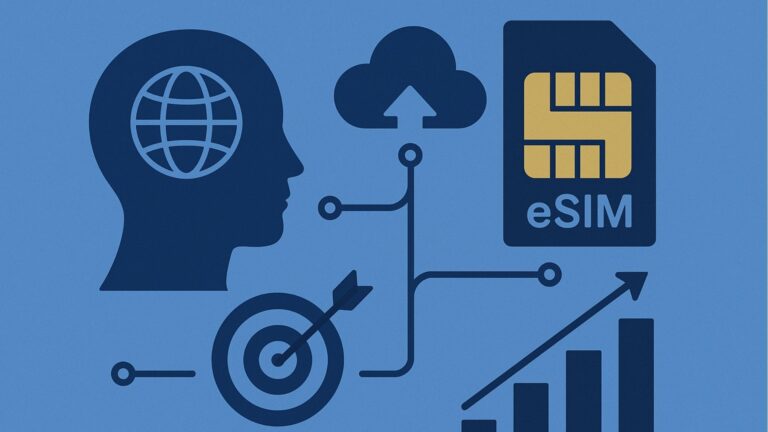How CFOs Can Slash Roaming Costs with a Centralized eSIM Data Pool
Managing corporate roaming costs is a growing challenge for CFOs in an increasingly mobile, global workforce. With a centralized eSIM data pool, companies can consolidate connectivity, eliminate bill shocks, and gain full visibility into data usage across teams. Voye Data Pool empowers finance leaders to optimize budgets while ensuring employees stay connected worldwide. Discover how smarter data pooling can turn connectivity from an expense into a strategic advantage.

For years, Chief Financial Officers (CFOs) have been grappling with unpredictable and inflated international roaming bills. Whether it’s a global sales team on the move, executives traveling for client meetings, or field operations spread across continents, roaming charges consistently eat into corporate budgets. Traditional mobile carriers make it difficult to track, predict, or optimize these costs.
The answer lies in a forward-looking connectivity model: the centralized eSIM data pool. Instead of managing dozens—or even hundreds—of fragmented mobile plans across employees, a CFO can consolidate usage into a shared data pool, accessible through eSIM technology. This modern approach not only slashes roaming costs but also improves financial predictability, compliance, and operational efficiency.
In this blog, we’ll explore why CFOs should adopt centralized eSIM data pools, how they transform telecom expense management, and the specific financial and strategic advantages they deliver.
Why Traditional Roaming Is a CFO’s Nightmare
1. Unpredictable Costs
Roaming fees vary wildly depending on country, carrier, and usage type. A single executive’s extended trip can generate thousands of dollars in unplanned charges—charges that often bypass pre-approval processes.
2. Complex Billing Structures
Carriers issue opaque invoices with multiple line items that make it nearly impossible for finance teams to track usage against cost centers. Reconciling these bills becomes a monthly headache.
3. Lack of Control
Employees often rely on local SIM cards, personal hotspots, or ad-hoc roaming plans. This leads to inconsistent expense reporting, compliance risks, and no central control over connectivity policies.
4. Employee Friction
Without affordable data access, employees may hesitate to use mobile connectivity abroad. This creates communication gaps, delayed decision-making, and productivity losses—all of which carry hidden financial costs.
The Rise of Centralized eSIM Data Pools
What Is an eSIM Data Pool?
An eSIM (embedded SIM) is a digital SIM that allows employees to connect to mobile networks worldwide without physically swapping SIM cards. A data pool is a shared allocation of mobile data that multiple employees or devices can draw from.
In a centralized eSIM data pool model, a company purchases one pool of data—say 1,000GB—that is distributed across employees as needed. If one traveler uses 20GB in London and another uses 2GB in Dubai, both draw from the same pool without triggering separate roaming charges.
Why This Matters for CFOs
- Predictability : One pool, one contract, one cost structure.
- Scalability : Easily add or remove employees without renegotiating contracts.
- Efficiency : Unused data is reallocated, eliminating waste.
- Compliance : Centralized visibility ensures usage aligns with company policy.
Direct Cost Savings for Enterprises
1. Elimination of Bill Shock
Instead of fragmented per-user roaming charges, CFOs see one predictable monthly fee. Variances are minimal, enabling accurate forecasting and budgeting.
2. Better Utilization of Data
In traditional plans, unused data from one employee is wasted, while another racks up overage charges. Data pools ensure all purchased data is used efficiently.
3. Lower Negotiation Barriers
Buying data in bulk through a centralized provider typically secures wholesale-level pricing, reducing per-GB costs significantly compared to consumer roaming rates.
4. Reduced Administrative Overheads
Finance and IT teams spend fewer hours managing invoices, disputes, and local SIM reimbursements—resulting in direct labor cost savings.
Strategic Advantages Beyond Savings
1. Global Workforce Agility
As businesses expand into new regions, employees can activate eSIM profiles instantly—no waiting for physical SIM cards or local telecom contracts.
2. Data Security & Compliance
Local SIMs often bypass corporate IT standards. With a centralized eSIM solution, CFOs can ensure secure, encrypted connectivity that meets compliance standards (GDPR, HIPAA, etc.).
3. Streamlined Reporting
With centralized dashboards, finance teams can monitor usage by region, department, or project. This enables granular cost allocation and strategic insights into travel ROI.
4. Employee Experience
Seamless connectivity means employees remain productive and connected abroad. This supports both revenue generation (through faster deal-making) and employee retention (by reducing travel friction).
CFO’s Playbook: Implementing an eSIM Data Pool
Step 1 : Assess Current Roaming Costs
Compile roaming expenses across the last 12 months. Identify top-traveling departments and the average cost per trip.
Step 2 : Evaluate Provider Options
Look for providers that offer :
- Global coverage across 130+ countries
- Transparent, predictable pricing
- Enterprise-grade dashboards and APIs
- Real-time usage tracking
Step 3 : Design the Policy Framework
- Define data allocations per region/role.
- Establish compliance rules (e.g., no tethering for personal devices).
- Integrate with expense reporting systems.
Step 4 : Deploy in Phases
Start with frequent travelers (executives, sales teams) before rolling out globally. Track savings in the pilot phase to build a business case for enterprise-wide adoption.
Step 5 : Monitor & Optimize
Use analytics dashboards to continuously adjust allocations. For example, increase data pools during peak travel seasons and reduce them during slow months.
Financial Impact : A Practical Example
Imagine a consulting firm with 200 traveling employees.
1. Traditional Roaming Model :
- Average roaming bill per employee: $300/month
- Total annual cost: $720,000
2. Centralized eSIM Data Pool :
- Enterprise plan of 2TB/month at $0.02/MB
- Monthly cost: $40,000 (all employees covered)
- Total annual cost: $480,000
Savings: $240,000 annually — without reducing employee travel or data usage.
The Role of CFOs in Driving Adoption
CFOs play a unique role in digital transformation projects that directly impact cost structures. While CIOs or CTOs may evaluate technical feasibility, CFOs are the ones pushing for ROI and compliance.
By spearheading eSIM adoption, CFOs can :
- Deliver immediate cost savings.
- Improve financial predictability.
- Enhance operational resilience in global markets.
- Position themselves as strategic enablers, not just cost controllers.
Overcoming Common Objections
“We already use local SIMs for cheaper rates.”
While local SIMs may be cost-effective, they create hidden costs in reimbursements, lost productivity, and compliance gaps. A centralized pool eliminates these inefficiencies.
“Isn’t this just another IT project?”
Unlike most IT initiatives, centralized eSIMs have direct financial ROI. CFOs can quantify the savings in hard dollars.
“What if employees overuse data?”
With centralized dashboards, limits and alerts can be set per user. This prevents abuse and ensures usage remains within policy.
Looking Ahead : The Future of Enterprise Connectivity
As 5G and IoT expand, organizations will need even more flexible connectivity models. CFOs who embrace centralized eSIM data pools today are future-proofing their companies for :
- Global remote workforces
- Smart IoT devices in logistics and supply chains
- On-demand connectivity for pop-up operations or field projects
In short, what began as a cost-control initiative becomes a platform for innovation and growth.
Conclusion
CFOs are under constant pressure to cut costs without compromising business performance. International roaming has long been a black hole in enterprise budgets—unpredictable, expensive, and difficult to control.
A centralized eSIM data pool changes this equation. By consolidating mobile data into one shared, transparent system, CFOs can :
- Slash roaming costs
- Simplify telecom expense management
- Enhance global workforce productivity
- Strengthen compliance and data security
For CFOs seeking a quick, measurable win that aligns finance with digital transformation, centralized eSIM data pools are no longer optional—they are essential.



 6 min read
6 min read





